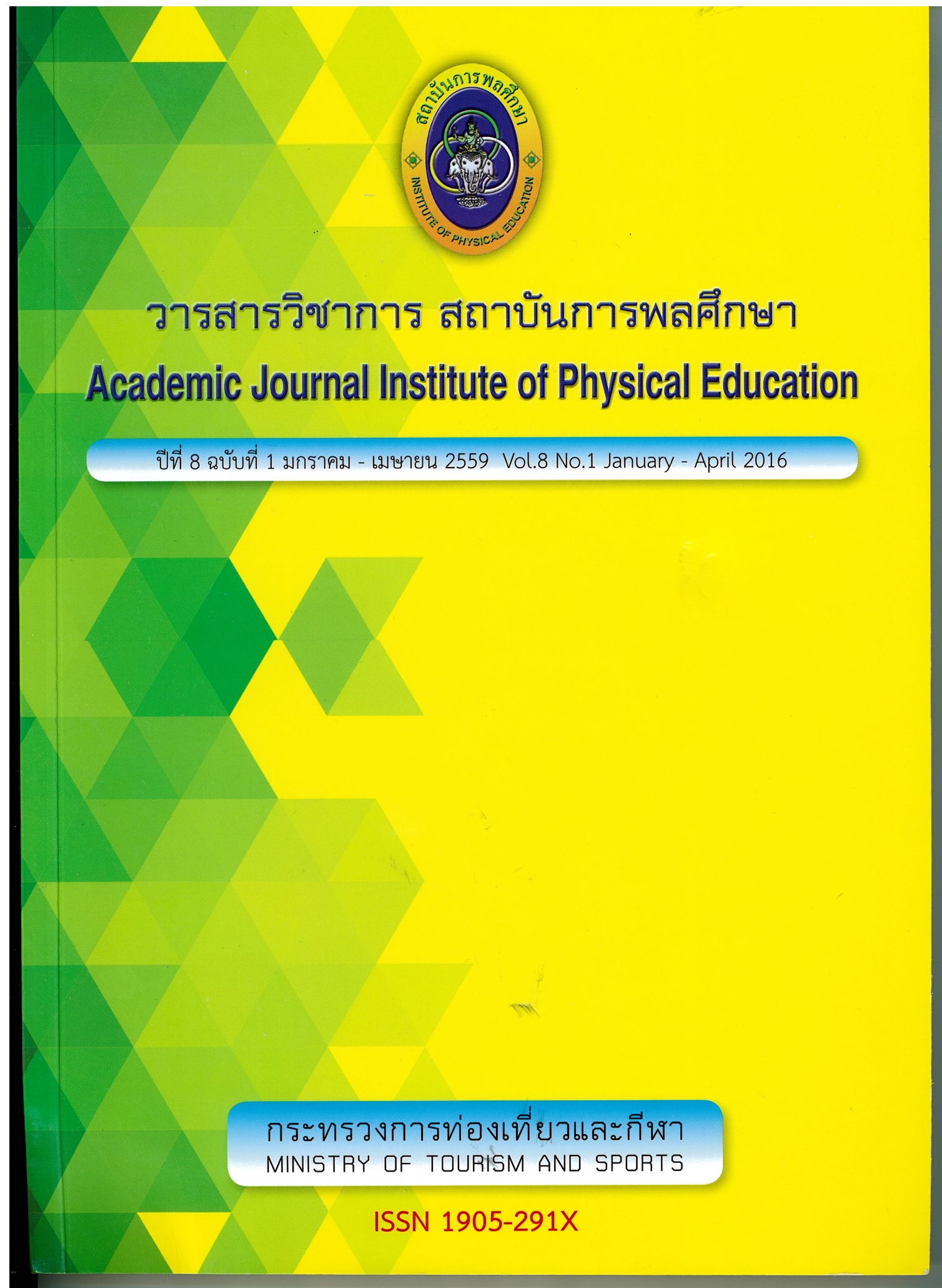The Construction of Course Standard for Principles and Methods of Teaching Soccer
Main Article Content
Abstract
The objectives of this research were to construct course standard and the performancebased assessment for the course of principles and methods of teaching soccer. Subjects were 42 physical education students, selecting by purposive sampling method, that enrolled in
es and methods of teaching soccer course in the first semester of 2013. The research instruments used were: 1) Questionnaire in form of rating scales; 2) Lesson plan; 3) Performancebased assessment form, and 4) Attitude questionnaire. Qualitative data were analyze by using content analysis. Percentage and mean were analyzed for numerical data.
The results were as follows: 1. Course standards for the course of principles and methods of teaching soccer consist of: a good attitude towards the profession, moral and ethics expression, and aware of their roles and responsibilities. 2. Having a better knowledge and understanding of soccer. 3. Application of basic skills and sport skills effectively. 4. Have Student-center approach for learning management, and assessment of learning effectively.
Model of performance-based assessment for the course of principles and methods of teaching soccer consist of 5 steps: 1) Defining topics; 2) Identify course standards, learning objectives, performance standards and indicators. 3) Determining the final work and scoring rubrics. 4) Defining essential knowledge, skills and performance. 5) Learning activities and performance assessment management, and 6) Defining media and learning resources. The implementing of lesson plans showed that most students were informed clearly on scoring rubrics which is used to guide students in developing learning.
Article Details

This work is licensed under a Creative Commons Attribution-NonCommercial-NoDerivatives 4.0 International License.
The published article is a copyright of the Academic Journal of Thailand National Sports University. The passage appeared in each article in this academic journal is a perspective of each author which is not related to the journal. Each author is required to be responsible for all components of his/her own article. If there are any mistakes, each author must be responsible for those mistakes on his/her own.
References
กรมวิชาการ กระทรวงศึกษาธิการ. (2539). การประเมินผลจากสภาพจริง, กรุงเทพมหานคร: กรมวิชาการกระทรวงศึกษาธิการ.
กิติชัย สุธาสิโนบล. (2546). 4MAT การจัดกระบวนการเรียนรู้เพื่อพัฒนาศักยภาพความเป็นมนุษย์ที่สมบูรณ์ของผู้เรียน. ราชบุรี: โรงพิมพ์ธรรมรักษ์การพิมพ์.
จิรณี ตันติรัตนวงศ์. (2551). กรอบมาตรฐานคุณวุฒิ: เส้นทางสู่มาตรฐานการเรียนรู้ของบัณฑิต (Online), http://www.mua.go.th/users/withanya/nqf/_.html, May 25, 2008.
จิราภรณ์ ศิริทวี. (2549). “กระบวนการวัดและประเมินผลการศึกษา”. หลักการวัดและการประเมินผลการศึกษา. กรุงเทพมหานคร: ภาควิชาการศึกษา คณะศึกษาศาสตร์ มหาวิทยาลัยเกษตรศาสตร์,
จุฑามาศ บัตรเจริญ. (2547). การพัฒนาระบบการวัดและประเมินผลสาระการเรียนรู้พลศึกษาตามมาตรฐานการเรียนรู้สุขศึกษาและพลศึกษา ในระดับมัธยมศึกษา วิทยานิพนธ์ครุศาสตรดุษฎีบัณฑิต สาขาวิชาพลศึกษา จุฬาลงกรณ์มหาวิทยาลัย.
ธีธัช เทียบทอง. (2548). การพัฒนาเกณฑ์การประเมินตามสภาพจริงวิชาทักษะและวิธีสอน กิจกรรมเข้าจังหวะ สําหรับนิสิตสาขาวิชาพลศึกษา มหาวิทยาลัยเกษตรศาสตร์ วิทยานิพนธ์ศิลปศาสตรมหาบัณฑิต สาขาวิชาพลศึกษา มหาวิทยาลัยเกษตรศาสตร์.
นาตยา ปิลันธนานนท์. (2545). จากมาตรฐานสู่ชั้นเรียน, กรุงเทพมหานคร: โรงพิมพ์ไทยวัฒนาพานิช.
นาตยา ปิลันธนานนท์, มธุรส จงชัยกิจ และศิริรัตน์ นีละคุปต์. (2542), การศึกษาตามมาตรฐาน: แนวคิดสู่การปฏิบัติ, กรุงเทพมหานคร: จูนพับลิชชิ่ง จํากัด.
บุญชม ศรีสะอาด. (2554). การวิจัยเบื้องต้น, พิมพ์ครั้งที่ 9. กรุงเทพมหานคร: บริษัท สุวิริยาสาส์น.
พรทิพย์ ไชยโส. (2541). “การประเมินการปฏิบัติ (Performance Based Assessment)”.สาระการศึกษา: การเรียนการสอน, กรุงเทพมหานคร: กองทุนศาสตราจารย์ ดร.อุบล เรียงสุวรรณ.
ไพเราะ อังศุสุกนฤมล. (2551). มิติใหม่การประเมินมาตรฐานความสามารถ สาระการเรียนรู้พลศึกษาสําหรับการศึกษาขั้นพื้นฐาน วิทยานิพนธ์ศึกษาศาสตรดุษฎีบัณฑิต สาขาวิชาหลักสูตรและการสอน มหาวิทยาลัยเกษตรศาสตร์.
สุรีย์ แก้วเศษ. (2553). รูปแบบการพัฒนาครูในการประเมินตามสภาพจริงวิชาพลศึกษา ระดับมัธยมศึกษา วิทยานิพนธ์ศิลปศาสตรดุษฎีบัณฑิตสาขาวิชาพลศึกษา, มหาวิทยาลัยเกษตรศาสตร์.
สุวิมล ตั้งสัจจพจน์ และกุลยา ตันติผลาชีวะ. (2542). การประเมินผลงานสะสมทางพลศึกษา. กรุงเทพมหานคร. บริษัทเอดิสันเพรสโปรดักส์ จํากัด.
Baumgartner, T.A., A.Ş. Jackson, M.T. Mahar, and D.A. Rowe. (2003). Measurement for Evaluation in Physical Education and Exercise Science. Boston, MA: McGraw-Hill.
Harrison J.M., C. L. Blakemore, and M. M. Buck. (2001). Instructional Strategies for Secondary School Physical Education. 5th. Boston, MA: McGraw-Hill.
Hopple, C.J. (2005). Elementary Physical Education Teaching & Assessment: a Practical Guide. Champaign, IL: Human Kinetics Publishers, Inc.
Lacy, A.C. and N.D. Hastad. (2003). Measurement and Evaluation in Physical Education and Exercise Science. San Francisco, CA: Benjamin Cummings.
Linn, R.L. and M. D. Miller. (2005). Measurement and Assessment in Teaching. 9th ed. Upper Saddle River, NJ: Pearson Education, Inc.
Lund, J. and D. Tannehill. (2005). Standards - Based Physical Education Curriculum Development. Sudbury, MA: Jones and Bartlett.
Lund, J.L. (2002). Creating Rubrics for Physical Education. Assessment Series Education. Reston, VA: NASPE Publication.
Lund, J.L. and M.F. Kirk. (2002). Performance - Based Assessment for Middle and High School Physical Education. Champaign, IL: Human Kinetic.
Melograno, J. V. (2006). Professional and Student Portfolios for Physical Education. Champaign, IL: Human Kinetics.
Miller, D.K. (2006). Measurement by the Physical Educator: Why and How. 5th ed. Boston MA: McGraw-Hill.
Morrow, J. R., A.W. Jackson, J.G. Disch, and D.P. Mood. (2000). Measurement and Evaluation in Human Performance. 2nd ed. Champaign, IL: Human Kinetics.
National Association for Sport and Physical Education. (2004). Moving into the Future National Physical Education Standards: A Guide to Content and Assessment. Boston MA: MWCB/McGraw-Hill.
Siedentop, D. (2004). Introduction to Physical Education, Fitness, and Sport. 5th ed. Boston, MA: McGraw-Hill.
Wiggins S. P. (1986). “Revolution in the Teaching Profession: A Comparative Review of Two Reform Reports”. Educational Leadership, 44(2): 56-59.


